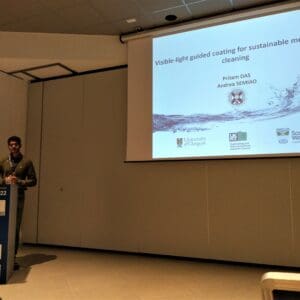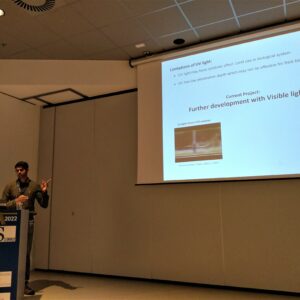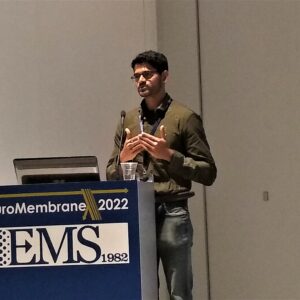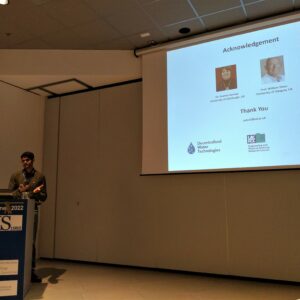Dr Pritam Das has given an oral presentation in the international conference ‘Euromembrane’ on 20 – 24 November 2022, Naples, Italy. It was organised by European Membrane Society.
Title: Visible light guided coating for sustainable membrane cleaning.
Biofouling is one of the major challenges in membrane processes. Membranes get exposed to a wide range of contaminants, e.g. natural organic matter (NOM), bacteria, proteins and polysaccharides resulting in irreversible biofouling. Light-responsive surface modifications are gaining significant attention to mitigate fouling in membrane processes for the ability to tune precisely the physicochemical and morphological properties that allow remote and contactless interactions without changing the original chemical environment [1,2]. Hence, in this project, a facile copolymer of light responsive unit (modified-Azobenzene) and zwitterionic unit was synthesised and coated on commercial nanofiltration NF270 membranes. The coated membranes impart antibiofouling properties during filtration due to the presence of zwitterionic moeities. In addition, after the filtration cycles, when exposed under alternate visible irradiation, azobenzene undergoes reversible photoisomerization between the trans and cis conformation leading to dynamic change of surface physico-chemical and morphological properties [3]. Therefore, irreversible fouling is cleaned by activating the azobenzene unit under complete visible (or near Infrared NIR) photoirradiation, resulting in clean membranes with high permeability and retention recovery. The photochemical conversion efficiency were systematically determined by NMR stoichiometry analysis, UV/Vis spectroscopy and DSC thermogram of the copolymer. Moreover we intend to understand the irreversible fouling removal efficiency of the modified membrane after filtration of water containing NOMs and bacterial (P. Putida) suspension. The light induced membrane process could be highly desirable for creating circular economy that could trigger interests for further development of renewable energy based separations, especially solar energy, without the consumption of fossil fuels.
Acknowledgements
The authors would like to acknowledge the Decentralised water Technologies project funded by Engineering and Physical Sciences Research Council (EPSRC), UK.
References
[1] Cheng, H. B. et al. Advances in Application of Azobenzene as a Trigger in Biomedicine: Molecular Design and Spontaneous Assembly (2021) Adv. Mater, 33, 2007290
[2] Ramanan, S. N. et al. Self-cleaning membranes for water purification by co-deposition of photo-mobile 4,4′-



